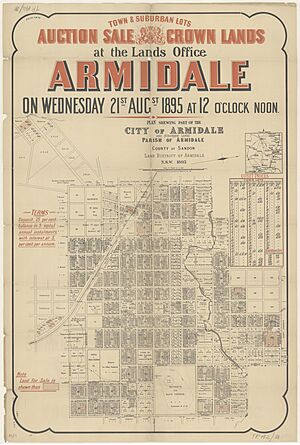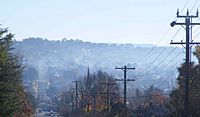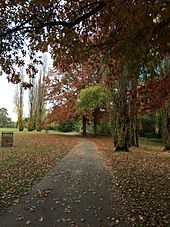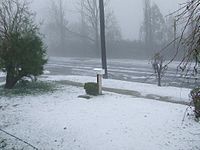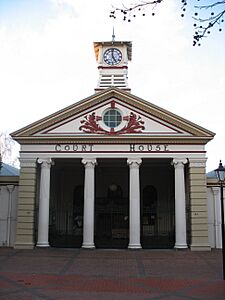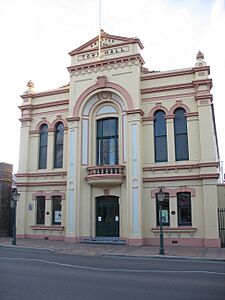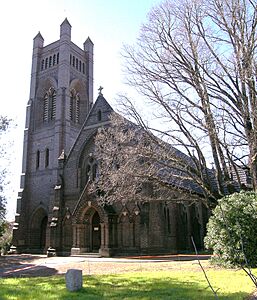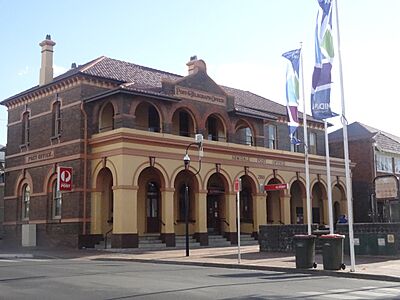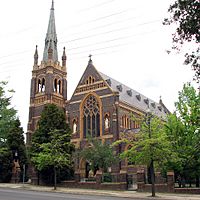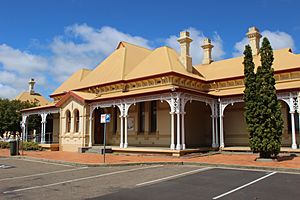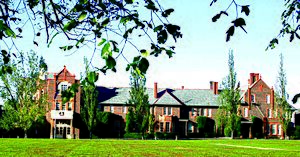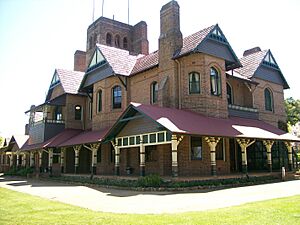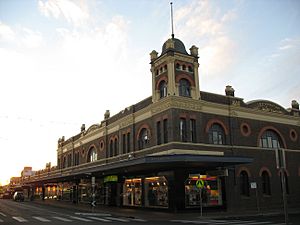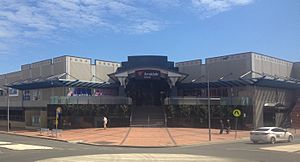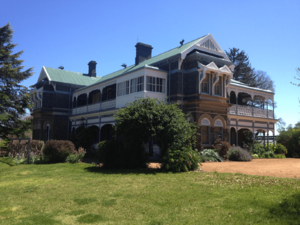Armidale facts for kids
Quick facts for kids ArmidaleNew South Wales |
|||||||||
|---|---|---|---|---|---|---|---|---|---|
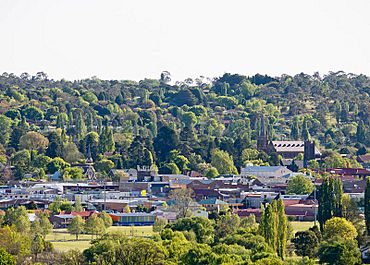
Looking across Armidale city, December 2013
|
|||||||||
| Established | 1849 | ||||||||
| Postcode(s) | 2350, 2351 | ||||||||
| Elevation | 980 m (3,215 ft) | ||||||||
| Location |
|
||||||||
| LGA(s) | Armidale Regional Council | ||||||||
| County | Sandon | ||||||||
| State electorate(s) | Northern Tablelands | ||||||||
| Federal Division(s) | New England | ||||||||
|
|||||||||
Armidale is a city in the Northern Tablelands area of New South Wales, Australia. In 2021, about 23,967 people lived there. It is the main city for the Northern Tablelands region. Armidale is located roughly halfway between Sydney and Brisbane. It sits where the New England Highway and Waterfall Way roads meet.
Armidale is known as a rural university town. It is home to the University of New England (UNE).
Contents
- History of Armidale
- Armidale's Geography
- About the City of Armidale
- Armidale's Population
- Armidale's Suburbs
- Getting Around Armidale
- Education in Armidale
- Shopping in Armidale
- Sports in Armidale
- Media in Armidale
- Fun Things to See and Do
- Historic Places in Armidale
- Famous People from Armidale
- Sister Cities
- See also
History of Armidale
Long ago, the Indigenous Anaiwan tribe lived in the area where Armidale is now.
British settlers first came to this region in the early 1830s. This was after John Oxley explored the area. Oxley said the land was good for grazing animals. Soon, large farms were set up. Armidale was started in 1839 by George James MacDonald. He was in charge of the local police. MacDonald built his police station here. He named the place after Armadale on the Isle of Skye in Scotland. This was his family's home.
The historic Armidale Post Office opened on April 1, 1843. The town was planned in 1848 and officially started in 1849. It was meant to be a place for farms to trade and get supplies. But soon, gold was found nearby at Rocky River. This led to a gold rush in the 1850s. The town grew very quickly.
The gold mining town of Hillgrove was about 40 km east of Armidale. It got electricity from Australia's first hydro-electric power system. You can still see parts of it on the Gara River. The nearby town of Uralla has the grave of Captain Thunderbolt. He was an outlaw who caused trouble in the 1860s. People in the area see him as a folk hero.
Armidale became a municipality (its own local government) in 1863. It was officially called a city in 1885.
In the early 1900s, an area just south of Armidale was considered to be Australia's capital city. Some thought its northern location was better for all eastern states. Later, in the 1920s and 1930s, people in Armidale wanted to form a new state. A local politician, David Drummond, helped Armidale get a teachers' college and later a university. This made the town a strong choice for a potential state capital.
Armidale's Geography
Armidale is located on the banks of Dumaresq Creek. It is in the New England region. The city is about halfway between Sydney and Brisbane. Its height above sea level is about 980 meters. Just east of Armidale are deep, forested gorges that drop down to the coast.
The area has many beautiful natural places. It also has several World Heritage national parks. These include the New England National Park and the Oxley Wild Rivers National Park. To the west is the Mount Yarrowyck Nature Reserve. A special type of forest called New England Peppermint Grassy Woodland is common here.
You can reach the coast at Coffs Harbour by driving along Waterfall Way. This two-hour drive goes through Dorrigo and Bellingen.
In winter, smoke from wood heaters can sometimes affect the air quality in Armidale.
Armidale's Climate
Armidale has a subtropical highland climate. This means it has a milder climate than many other parts of northern New South Wales. Summers are warm, but winters are long and cool. Many nights have frost. Snowfall is rare, happening about once every three years.
Armidale has four clear seasons, which is different from much of inland Australia. This is why it's called "New England." The autumn colours are a famous sight. Summers have warm days and cool nights. Thunderstorms often bring heavy rain and sometimes hail in the afternoons. Temperatures usually do not feel too humid. Days above 30°C happen about 13 times a year. They rarely go above 35°C. The hottest temperature recorded was 37.1°C in February 2017.
In autumn, leaves change colour and fall. Days are still warm, especially in March and April. Days are sunny, and thunderstorms are less common. Nights get colder, and thick fog often covers the valley in the morning. But the fog usually clears by 9 am for a sunny day. The first frosts usually happen in April, but they are not severe.
Winters are cold. Overnight temperatures often drop below -5°C, with frost on the ground. The coldest recorded temperature was -11.2°C in June 2010. These cold mornings are usually followed by sunny days. Day temperatures can reach 16°C, but sometimes stay below 10°C. Winter days can be grey with westerly winds and light rain, and very rarely snow.
In spring, temperatures get warmer. But morning frosts can still happen into October. September is usually mild but windy. By late October, it gets warmer and more humid. Thunderstorms become more common with more rain. Spring has the most changeable weather of the year. Warm, sunny weeks can be followed by cooler days, before warming up again. This cycle often repeats until summer begins.
| Climate data for Armidale (Tree Group Nursery, 1997–2023); 987 m AMSL; 30.52° S, 151.67° E | |||||||||||||
|---|---|---|---|---|---|---|---|---|---|---|---|---|---|
| Month | Jan | Feb | Mar | Apr | May | Jun | Jul | Aug | Sep | Oct | Nov | Dec | Year |
| Record high °C (°F) | 37.4 (99.3) |
37.6 (99.7) |
33.8 (92.8) |
28.0 (82.4) |
24.8 (76.6) |
22.3 (72.1) |
21.2 (70.2) |
27.4 (81.3) |
28.7 (83.7) |
32.4 (90.3) |
35.6 (96.1) |
37.8 (100.0) |
37.8 (100.0) |
| Mean daily maximum °C (°F) | 27.1 (80.8) |
25.7 (78.3) |
23.8 (74.8) |
20.5 (68.9) |
16.6 (61.9) |
13.5 (56.3) |
13.2 (55.8) |
14.9 (58.8) |
18.6 (65.5) |
21.4 (70.5) |
23.5 (74.3) |
25.7 (78.3) |
20.4 (68.7) |
| Mean daily minimum °C (°F) | 13.0 (55.4) |
12.7 (54.9) |
10.8 (51.4) |
6.8 (44.2) |
2.3 (36.1) |
0.8 (33.4) |
−0.3 (31.5) |
−0.2 (31.6) |
2.8 (37.0) |
6.0 (42.8) |
9.2 (48.6) |
11.5 (52.7) |
6.3 (43.3) |
| Record low °C (°F) | 2.6 (36.7) |
2.5 (36.5) |
−1.7 (28.9) |
−5.8 (21.6) |
−7.9 (17.8) |
−11.2 (11.8) |
−10.8 (12.6) |
−8.7 (16.3) |
−6.2 (20.8) |
−3.5 (25.7) |
−3.0 (26.6) |
−0.5 (31.1) |
−11.2 (11.8) |
| Average rainfall mm (inches) | 89.4 (3.52) |
96.6 (3.80) |
73.9 (2.91) |
37.2 (1.46) |
31.8 (1.25) |
40.6 (1.60) |
40.1 (1.58) |
45.4 (1.79) |
46.3 (1.82) |
70.6 (2.78) |
92.7 (3.65) |
90.6 (3.57) |
755.2 (29.73) |
| Average rainy days (≥ 0.2mm) | 11.1 | 11.6 | 10.9 | 8.3 | 7.8 | 10.5 | 9.5 | 8.3 | 8.1 | 10.4 | 11.3 | 11.8 | 119.6 |
| Average afternoon relative humidity (%) | 49 | 55 | 53 | 53 | 53 | 58 | 55 | 47 | 45 | 46 | 53 | 48 | 51 |
| Source: Bureau of Meteorology | |||||||||||||
| Climate data for Armidale Airport AWS (1994–2023); 1,079 m AMSL; 30.53° S, 151.62° E | |||||||||||||
|---|---|---|---|---|---|---|---|---|---|---|---|---|---|
| Month | Jan | Feb | Mar | Apr | May | Jun | Jul | Aug | Sep | Oct | Nov | Dec | Year |
| Record high °C (°F) | 37.0 (98.6) |
37.1 (98.8) |
32.4 (90.3) |
27.7 (81.9) |
23.3 (73.9) |
21.7 (71.1) |
19.9 (67.8) |
26.8 (80.2) |
28.2 (82.8) |
31.9 (89.4) |
35.0 (95.0) |
36.5 (97.7) |
37.1 (98.8) |
| Mean daily maximum °C (°F) | 26.2 (79.2) |
25.0 (77.0) |
23.1 (73.6) |
19.8 (67.6) |
15.8 (60.4) |
12.7 (54.9) |
12.2 (54.0) |
14 (57) |
17.6 (63.7) |
20.5 (68.9) |
22.8 (73.0) |
25.0 (77.0) |
19.6 (67.3) |
| Mean daily minimum °C (°F) | 13.5 (56.3) |
13.1 (55.6) |
11.5 (52.7) |
7.8 (46.0) |
4.4 (39.9) |
2.4 (36.3) |
1.4 (34.5) |
1.8 (35.2) |
4.7 (40.5) |
7.4 (45.3) |
10.0 (50.0) |
12.1 (53.8) |
7.5 (45.5) |
| Record low °C (°F) | 4.5 (40.1) |
4.1 (39.4) |
1.1 (34.0) |
−3.3 (26.1) |
−5.9 (21.4) |
−6.0 (21.2) |
−7.0 (19.4) |
−6.6 (20.1) |
−4.9 (23.2) |
−3.1 (26.4) |
−1.6 (29.1) |
1.3 (34.3) |
−7.0 (19.4) |
| Average rainfall mm (inches) | 91.9 (3.62) |
96.1 (3.78) |
67.7 (2.67) |
35.1 (1.38) |
40.4 (1.59) |
48.2 (1.90) |
44.0 (1.73) |
43.2 (1.70) |
52.1 (2.05) |
74.7 (2.94) |
95.8 (3.77) |
102.9 (4.05) |
792.1 (31.18) |
| Average rainy days (≥ 0.2mm) | 12.1 | 13.0 | 12.7 | 11.2 | 12.1 | 14.9 | 13.4 | 9.9 | 10.1 | 11.5 | 12.5 | 13.2 | 146.6 |
| Average afternoon relative humidity (%) | 52 | 58 | 53 | 49 | 55 | 60 | 56 | 48 | 46 | 46 | 54 | 51 | 52 |
| Source: Bureau of Meteorology | |||||||||||||
Severe Weather Events
Armidale has had several strong hailstorms. Three big storms happened between 1996 and 2006.
On September 29, 1996, hail as big as 80 mm fell. Winds reached 150 km/h. The area was called a disaster zone. Damage was estimated to be over A$200 million.
On January 1, 2000, many homes were damaged. This was due to large hail, strong winds, and flash flooding.
On December 21, 2006, hail, high winds, and flash flooding damaged over 1,000 homes. The Armidale Livestock Exhibition Centre completely fell down. The city was declared a state of emergency the next day.
On October 14, 2021, a strong storm produced a tornado. It caused a lot of damage. Roofs were torn off, and cars were flipped over.
About the City of Armidale
Armidale is a city with cathedrals. It is the main seat for the Anglican and Roman Catholic bishops of Armidale. St Peter's Anglican Cathedral was designed by John Horbury Hunt. It opened in 1875. The Catholic Cathedral of St Mary and St Joseph opened in 1919.
The city center is set out in a grid pattern. The main street is Beardy Street. It was named after two early settlers who had beards. The courthouse was built in the 1850s and is still a key building. Most of the rest of the city is homes.
The Australian Wool Fashion Awards happen in Armidale every March. They show off designs using Merino wool. The Autumn Festival is a popular event in April. It has a street parade, stalls, and celebrations. This festival promotes Armidale's different cultures and its beautiful autumn colours. In May, the New England Wool Expo takes place. It features wool fashions, crafts, and shearing contests.
Armidale's Population
| Historical population | ||
|---|---|---|
| Year | Pop. | ±% |
| 1921 | 5,407 | — |
| 1933 | 6,794 | +25.7% |
| 1947 | 7,809 | +14.9% |
| 1954 | 8,661 | +10.9% |
| 1961 | 12,875 | +48.7% |
| 1966 | 15,360 | +19.3% |
| 1971 | 18,156 | +18.2% |
| 1976 | 19,711 | +8.6% |
| 1981 | 18,922 | −4.0% |
| 1986 | 19,525 | +3.2% |
| 1991 | 21,605 | +10.7% |
| 1996 | 21,330 | −1.3% |
| 2001 | 20,068 | −5.9% |
| 2006 | 21,660 | +7.9% |
| 2011 | 22,468 | +3.7% |
| 2016 | 23,352 | +3.9% |
| 2021 | 23,967 | +2.6% |
| Source: Australian Bureau of Statistics data. | ||
The 2021 census counted 23,967 people in the Armidale urban area.
- About 7.9% of the people were Aboriginal and Torres Strait Islander.
- Most people (74.0%) were born in Australia. Other common birthplaces included Iraq (2.4%), England (2.0%), and India (1.1%).
- Most people (78.6%) spoke only English at home. Other languages included Kurdish (1.1%) and Nepali (1.1%).
- The most common religions were No Religion (36.1%), Catholic (16.7%), and Anglican (16.1%).
Armidale is also home to an Êzidî community of about 650 people.
Armidale's Suburbs
- Acacia Park
- East Armidale
- West Armidale
- Ben Venue
- Bona Vista
- Commissioners Waters
- Dumaresq
- Duval
- Madgwick
- North Hill
- Newling
- Soudan Heights
- South Hill
- St. Patrick's
- The Mission
Getting Around Armidale
The Armidale railway station is on the Main North railway line. Daily passenger trains connect to and from Sydney. Armidale's airport has five daily flights to Sydney with Qantaslink. Link Airways also flies between Armidale and Brisbane. Armidale Airport is the highest licensed airport in New South Wales, at 1,084 meters.
You can also travel by daily coach (bus) to Tenterfield. Other bus companies like Greyhound offer many daily services. Local city buses run on six different routes. Armidale also has 16 taxis.
Cycling is a good way to get around Armidale, even with some hills. A cycleway runs from the University of New England through the city. It goes to the eastern residential areas. This path makes it easy for cyclists to reach shopping centers. Bicycle racks are available in the city center. There are also marked cycleways on the shoulders of roads in the southern areas. Separate cycleways lead to the Armidale Arboretum and the Armidale State Forest.
Education in Armidale
Armidale has many schools and education centers. These include private schools like The Armidale School (1894), New England Girls' School (1895), and Presbyterian Ladies' College (1887). There is also the Armidale Waldorf School (1985). O'Connor Catholic College (1975) and St Mary's Primary School are Catholic schools.
Armidale High School (1911) and Duval High School (1972) were government high schools. They closed at the end of 2018. In 2019, these two schools combined to form Armidale Secondary College. It is located on the old Armidale High School campus. About 27% of Armidale's population is aged 10–24. This is higher than the average for New South Wales.
University of New England
The university started in 1938 as a college of the University of Sydney. It became its own university in 1954. The UNE helps make Armidale a city with lots of culture and different people. It has a lively arts scene. The university works closely with the rural community. It does a lot of research in farming. There is also a strong focus on technology and humanities studies.
UNE offers many different courses. In 2008, it started new programs, including a five-year medical science and doctor program. This is part of a joint program with the University of Newcastle. The university is built around the historic mansion Booloominbah. This building is now used for offices and has a restaurant. UNE is one of the city's biggest employers.
Shopping in Armidale
Armidale is a big shopping center for the region. It has three main shopping malls:
- Central Armidale. This mall cost A$49 million to build. It has a Woolworths, Kmart, and 32 smaller shops. It opened in late 2007.
- Armidale Plaza. This mall had a A$70 million expansion and update in 2007. It has a and 50 smaller shops.
- The East Mall was built in 2002. It has a Coles Supermarket and 15 smaller shops.
The Pedestrian Mall
Armidale has a pedestrian mall in the city center. It covers three blocks of Beardy Street. It has many shops and cafés with outdoor seating. You can also see interesting buildings there. These include Tattersalls Hotel, the Armidale Courthouse, and the main post office. The mall opened in 1973. It was the first of its kind in regional Australia.
The Armidale Dumaresq Council has been improving the mall since 2003. This project aims to make traffic flow better in the city center. It uses signs and special paving to guide cars around the main area.
Sports in Armidale
The most popular sport in Armidale is rugby union. The city has four teams in the New England Rugby Union. These are Armidale Blues, Barbarians, Robb College, and St. Albert's College. The last two teams are mostly made up of university students.
Rugby league is also very popular. Armidale has two teams in Group 19 Rugby League. They are the Armidale Rams RLFC and the Narwan Eels. The Eels club has a strong Indigenous influence. The Rams play at Rugby League Park. The Eels play at Newling Oval.
Other sports teams include the UNE New England Nomads (an Australian Rules Football team). There are also various soccer teams in the local SportUNE League.
Media in Armidale
The city has one local newspaper. It also has many radio stations, including four local ones. All major television stations are available.
Local Newspapers
- Armidale Express
- Armidale Express Extra
Local Radio Stations
- TUNE! FM, one of Australia's oldest community radio stations for young people.
- 2AD/FM100.3, a commercial station.
- 2ARM 92.1 FM, a community radio station run by volunteers.
- 88.0 is a special tourist radio station.
- 87.6 Raw FM Australia (Dance Floor Radio Network).
National Radio Stations
- Triple J
- ABC Radio National
- ABC Classic FM
- 2KY National Racing Service
- ABC Local Radio
Television Stations
- Seven (Prime7), 7two, 7mate, 7flix, 7Bravo – owned by Seven Network.
- Nine (NBN), 9Go!, 9Gem, 9Life – owned by Nine Network.
- WIN Television, 10 Bold Drama, 10 Peach Comedy – linked to Network Ten.
- ABC, ABC TV Plus, ABC Kids, ABC Me and ABC News – from the Australian Broadcasting Corporation.
- Special Broadcasting Service, SBS, SBS Viceland, SBS Food, SBS WorldWatch, SBS World Movies and NITV.
You can also get Subscription Television services from Foxtel.
Fun Things to See and Do
- Armidale and Region Aboriginal Cultural Centre and Keeping Place
- Oxley Wild Rivers National Park, with Dangar Falls and Gorge and Gara Gorge
- Saumarez Homestead
- New England Regional Art Museum
- Cathedral Rock National Park
- Waterfall Way and Wollomombi Falls
- Mount Yarrowyck Aboriginal Rock Art site
- Gemstone fossicking (looking for gems)
Historic Places in Armidale
Armidale has many places listed for their history. These include:
- 158 Beardy Street: Armidale Post Office
- 164 Beardy Street: Commercial Bank of Australia Building
- 216 Brown Street: Armidale railway station turntable
- 234 Brown Street: Armidale railway station
- 125 Dangar Street: Central Park, Armidale
- 132 Dangar Street: Saints Mary and Joseph Catholic Cathedral
- 108 Faulkner Street: Lands Board Office
- 60 Madgwick Drive: Booloominbah
- 122–132 Mossman Street: Old Teachers' College
- 36 Roseneath Lane: Roseneath
- 122 Rusden Street: St Peter's Cathedral
- 230 Saumarez Road: Saumarez Homestead
- Allingham Street: Hunter River Lancers Training Depot
Famous People from Armidale
Many notable people were born in, live in, or have lived in Armidale.
- Peter Allen, singer and performer
- Jillian Banfield, scientist who studies tiny life forms in rocks
- Archie Barwick, farmer and WWI soldier
- Jack Bedson, children's author and poet
- Kate Bell, actress
- Anya Beyersdorf, actress
- Leigh Blackmore, writer and editor
- Michele Bullock, economist
- Alex Buzo, playwright
- Zelman Cowen, former Governor General of Australia
- Bruce Devlin, professional golfer
- Edward Doody, Catholic bishop
- Cadel Evans, professional cyclist
- Hugh Gordon, animal parasite expert
- Fergus James, singer-songwriter
- Anthony Kelly, martial artist
- Mary Kirkpatrick, first trained midwife on the Mid North Coast
- Sir Frank Kitto, former High Court Judge
- John McIntosh – Australian politician
- John Monckton (1938–2017) Olympic swimmer
- Anne Plunkett, Australian Ambassador
- Gayla Reid, writer
- Steven Conte, writer
- Nich Richardson, television presenter
- Frank Roberts, boxer
- Joe Roff, rugby union player
- Caroline Ann Rowland, founder of St Ursula's College, Armidale
- Sir Mark Sheldon, businessman
- Angelina Sondaq, Miss Indonesia 2001 and politician
- Elzear Torreggiani, Catholic bishop
- Peter Turnbull, WW2 fighter pilot
- Margaret Vyner, model and actress
- Don Walker, keyboardist for Cold Chisel
- George Warnecke, journalist and publisher
- Dean Widders, rugby league player
- Sir Thomas George Wilson, doctor
- Judith Wright, poet
Sister Cities
 Masterton, New Zealand
Masterton, New Zealand
See also
 In Spanish: Armidale para niños
In Spanish: Armidale para niños



